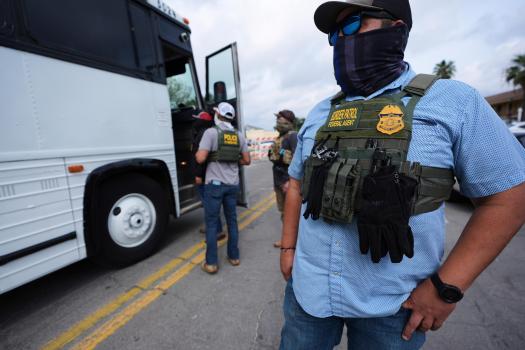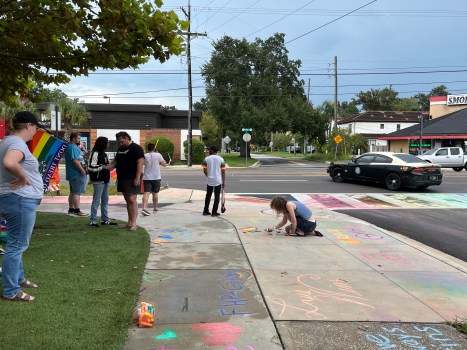Following a traffic check, four Guatemalan siblings were arrested as undocumented immigrants and held at the Orange County Jail for several days last week before being taken in a van and driven around for hours.
According to their lawyers, they have finally arrived at their destination: the Orange County Jail.
Rules restricting the amount of time an undocumented immigrant can be detained in a local institution before federal officials must take possession caused this aimless journey, which is comparable to what some other detainees in Florida have experienced in recent months.
Because the changeover resets the clock and provides federal Immigration and Customs Enforcement officers additional time to pick up detainees, detainees are being moved from one federal detention center to another as a result of the Trump administration’s campaign for mass deportations that are filling jail beds.
Law enforcement officials in Orange and Pinellas County attested to the practice, and several immigration lawyers told the Orlando Sentinel about the shuffle.
However, the lawyers claim it’s a frustrating strategy that frequently leaves them unable to find the immigrants and prevents inmates from having access to their loved ones and due process.
Walker Smith, an immigration lawyer in Orlando, said he was unable to locate his clients’ three brothers and a sister, despite the fact that they ended up where they had begun, because their prior prisoner numbers had been altered upon their return, leaving him and their family in the dark about their whereabouts. According to him, the family’s two youngest siblings, ages 18 and 26, had legitimate work permits.
If they are simply detaining individuals indefinitely, moving them between facilities, or worse, relocating them from one prison to another while using a different number, “It’s the best kind of system-gaming,” Smith added.
Since then, the younger brother has been transferred once more, this time to the state’s new Everglades prison facility, Alligator Alcatraz.
A detained immigrant’s custody clock operates in a convoluted manner.
Undocumented immigrants without criminal charges may be detained for up to 72 hours before ICE arrives to pick them up, according to the Intergovernmental Service Agreement, or IGSA, which regulates ICE’s interactions with the few Florida jails, such as Orange County’s, that temporarily house detainees. The 72-hour clock, however, may not begin if the immigrant is arrested for a different crime until the other case is charged or dropped for all arrestees, or until bail is granted and paid, as stipulated by state law, which has a two-day restriction.
According to Smith, once the 72-hour time has passed, no agency, jail, or other organization has the right to keep those individuals in custody. Thus, they ought to be freed.
Additionally, immigrants with an ICE hold were frequently released if time passed without any action previous to the Trump administration. Some of them are now only moved, either for a short ride or to another jail.
The frequency of the scenario is still unknown.
Orange Corrections Chief Louis Quiones told the Board of County Commissioners during a meeting on July 15 about a shuffle that took place in early July and involved a lot of people.
Commissioner Maribel Gomez Cordero, who had been informed of the practice by campaigners urging commissioners to end the IGSA with ICE, was asking him questions.
We had a lot of people who were approaching the 72-hour mark around the [July 4] holiday, and ICE had to come retrieve them. They were going to try to move them somewhere else, he said. They brought them back to Orange County Corrections since that did not go as planned.
The fact that keeping someone in the jail costs roughly $145 per day and that Orange County only receives about $88 per day from the federal government to house inmates is one of the reasons why some county officials find the problem annoying. People’s stays are prolonged and costs are increased when they are moved in and out of the jail. The county is currently attempting to renegotiate its contract with ICE in order to obtain a better reimbursement rate, but they have not yet reached an agreement.
The county did not make Qui One available for an interview with the Orlando Sentinel, and he did not specify the number of people affected by the transfer.
Smith, however, expressed skepticism about Qui’s portrayal.
He made an effort to give the impression that it was an isolated incident, Smith claimed. That the [Guatemalan] man I went to speak with had also experienced the same thing piqued my interest.
The county’s public safety director, Danny Banks, added that the shuffle has only happened once thus far.
He stated in a text message that ICE has been moving its prisoners primarily within the 72-hour window specified in the IGSA agreement.
The Orlando Sentinel has been informed of several such incidents, though. Michael Borrego Fernandez, a native of Cuba, was the subject of one of the most complex; he was taken to several different institutions before arriving to Alligator Alcatraz, where he has resided since July 5.
After being charged with grand theft for defrauding homeowners of the upfront payment for swimming pools but failing to complete the work, Borrego Fernandez was arrested in June for violating his release terms. According to his mother Yaneisy Fernandez Silva, this was because he unintentionally worked for a businessman who was running the scam.
According to her, South Florida resident Borrego Fernandez was brought to the Seminole County Jail to spend ten days behind bars.
He was placed on an ICE hold at Orange County Jail after serving his term, and three days later, he was transferred to Pinellas County Jail. According to his mother, he was taken back to Orange County Jail three days later. After around four days, he called his mother to inform her that he had arrived to Alligator Alcatraz.
Fernandez Silva claimed that only his phone conversations provided hints that allowed her to look up her son in jail databases.
According to immigration lawyer Mich Gonzalez of South Florida, who described the transfers as concerning, it is evident what the counties are doing: they are attempting to open a legal loophole to a constitutional requirement that individuals not be detained for more than 72 hours.
According to Gonzalez, conditions for incarcerated people who roam around differ from those for individuals who are kept in a single jail.
According to Gonzalez, they are handcuffed, shackled, and occasionally waist-chained. They aren’t given the right diet, unlike when they are detained at a county jail, where it’s standard procedure to be given three meals a day and water. However, that is irrelevant when you are being moved and transferred.
A Mexican guy was arrested in June as he and his brother were being driven to a construction site by their U.S.-citizen supervisor. According to one of the brothers’ wives, both were in the automobile and had licenses to work in the United States.
Because she fears that her remarks could make her a target for immigration authorities, she spoke to the Sentinel under the condition of anonymity.
She was unaware of her husband’s whereabouts for weeks following his detention. Despite calling from a number in Orange County, he was not listed in the database of the correctional system. He returned to Orange County Jail the following day after telling his wife he had been loaded into a vehicle and driven somewhere.
She remarked in Spanish, “I was so scared when I didn’t hear from him for three days.” He stayed in Orange County Jail for so long that he recognized it was the same place when he came back.
In an effort to locate him, family advocates met with Orange County Corrections authorities in early July. They say he was eventually found in a county jail cell six hours later. The uncertainty was exacerbated by the fact that he had been assigned a different inmate number upon his release.
Sheriff Bob Gualtieri of Pinellas County acknowledged that there has been some reorganization at his institution, but he defended it by claiming that it is due to a capacity problem that sometimes keeps detention facilities from taking in inmates as their 72-hour clock runs out.
The transportation system backs up and they have to place them in IGSA jails like Orange if it is overcrowded or there isn’t space at Krome. “Gualtieri said.”
The Immigration Enforcement Council of Florida, of which Gualtieri is a member, has expressed concern that the number of undocumented immigrants being arrested by Florida law enforcement agencies is outpacing the capacity of federal detention facilities.
Instead of sending inmates to the seven Florida jails with IGSA agreements while they await ICE detention, the board has urged the federal government to let more local jails to keep them.










